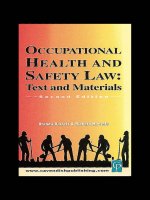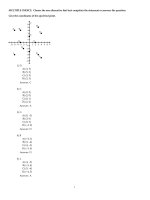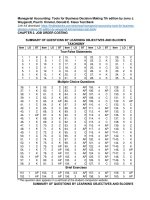Management of occupational health and safety 7th edition by kelloway francis gatien test bank
Bạn đang xem bản rút gọn của tài liệu. Xem và tải ngay bản đầy đủ của tài liệu tại đây (124.87 KB, 12 trang )
Management of Occupational Health and Safety 7th edition by Kevin
Kelloway, Lori Francis, Bernadette Gatien Test Bank
Link full download: />
Chapter 2. LegislativeFramework
MULTICHOICE
1. WHMIS legislation applies to which type of workplace hazards?
(A) biological hazards
(B) chemical hazards
(C) psychological hazards
(D) physical hazards
Answer : (B)
2. Which of the following is NOT an employer general duty?
(A) appoint a competent supervisor
(B) prepare policies regarding workplace violence and workplace harassment
(C) appoint a Board of Directors
(D) inform supervisors and workers of possible hazards
Answer : (C)
3. Which of the following provides guidelines for the presentation of information on chemical hazards in the
workplace?
(A) the Chemical Recognition and Information System
(B) the Workplace Hazardous Materials Information System
(C) the Workers' Compensation Act
(D) the Dangerous Goods Act
Answer : (B)
4. What are the two essential limitations on the right to refuse unsafe work outlined in OH&S Acts across Canada?
(A) There are no limits on the right to refuse unsafe work in Canadian jurisdictions.
(B) The worker has previously performed the task, or the refusal would place another person's safety in jeopardy.
(C) The employee works in a declared profession such as policing, or the refusal would place another
person's safety in jeopardy.
(D) The task in question is a normal condition of employment, or the refusal would place another person's safety in
jeopardy.
Answer : (D)
5. Edwin is the owner of a chain of autobody shops in New Brunswick. He has been charged with criminal negligence
causing death following a fatal incident at one of his shops. These charges have been laid under which of the following
pieces of legislation?
(A) the Criminal Code of Canada
(B) the federal OH&S Act
(C) the New Brunswick OH&S Act
(D) the New Brunswick Crimes Act
Answer : (A)
6. Ella and Anwar are certified members of the JHSC at an Ontario-based cleaning products manufacturer. Ella
represents the management side and Anwar the employee side. When they noticed that there was a problem with the
ventilation at their main plant they agreed to halt operations. Which of the following have Ella and Anwar
enacted?
(A) a bilateral work stoppage
(B) a unilateral work stoppage
(C) the right to refuse unsafe work
(D) a safety inspection
Answer : (A)
7. Which of the following systems for the classification and labelling of chemicals is being adopted by countries around
the world?
(A) OHSA
(B) ISO
(C) CSA
(D) GHS
Answer : (D)
8. What is the term for the specific rules that are not legally enforceable unless referred to in a
regulation or an act?
(A) codes
(B) standards
(C) enforcements
(D) guidelines and policies
Answer : (D)
9. Which of the following is a duty described under OH&S legislation to be undertaken because of a health and safety
regulation?
(A) mandated duty
(B) general duty
(C) prescribed duty
(D) safety duty
Answer : (C)
10. Tim works at a machine shop. He notices that one of the guards on a grinder is very loose and not working properly.
What duty does he have under OH&S legislation?
(A) tell his supervisor about the defective equipment
(B) start a stop work order
(C) fix the guard himself
(D) none, unless there is anincident
Answer : (A)
11. An employee expressed her concerns to her supervisor that the scaffolding she was working on for a paintingjob had
several loose bolts. She was concerned for her safety and requested the supervisor's permission to stop working
immediately. However, the supervisor insisted that she continue working. What employee right did the supervisor's
behaviour violate?
(A) the employee's right to refuse unsafe work
(B) the employee's right to report unsafe conditions
(C) the employee's right to participate in health and safety programs
(D) the employee's right to a safe workplace
Answer : (A)
12. What workers' rights are included in federal and provincial legislation?
(A) the right to know, the right to rehabilitation, and the right to refuse unsafe work
(B) the right to participate, the right to rehabilitation, and the right to refuse unsafe work
(C) the right to know, the right to participate, and the right to refuse unsafe work
(D) the right to know, the right to be compensated for injury, and the right to refuse unsafe work
Answer : (C)
13. In which circumstances does a ministry inspector/officer get involved in a work refusal situation?
(A) when a worker identifies an unsafe work situation
(B) when a worker refuses to return to work after a full internal investigation has deemed there is no danger
(C) when a worker is told by the certified worker that he or she is endangered
(D) when a number of workers refuse to work
Answer : (B)
14. Which of the following is a primary duty that is directly articulated in an OH&S Act?
(A) mandated duty
(B) general duty
(C) prescribed duty
(D) safety duty
Answer : (B)
15. All Canadian OH&S legislation includes which of the following elements?
(A) Act, powers of enforcement, right to refuse, protection from reprisals, duties/responsibilities
(B) Act, regulations, guidelines, standards/codes
(C) Act, stakeholder enforcement, duties/responsibilities
(D) Act, right for referral, protection from reprisals, standards/codes
Answer : (A)
16. D'Mari is a construction site supervisor on major commercial buildings. Part of his job is to follow provincial fire
safety regulations. This is best described as which type of duty?
(A) mandated
(B) general
(C) safety
(D) prescribed
Answer : (D)
17. What is the PRIMARY function of the joint health and safety committee?
(A) to communicate with the Ministry of Labour
(B) to provide a nonadversarial opportunity for labour and management to work together to create a safer workplace
(C) to conduct OH&S meetings
(D) to ensure that safety messages are communicated
Answer : (B)
18. What is the most commonly found provincial requirement regarding which workplaces require a Joint Health and
Safety Committee?
(A) workplaces with 10 or more employees
(B) workplaces with 15 or more employees
(C) workplaces with 20 or more employees
(D) workplaces with 25 or more employees
Answer : (C)
19. Sharon Nelson is the bakery manager and is a certified member of the JHSC at the grocery store where she works.
According to legislation, which of the following employees must also be certified as a member of theJHSC?
(A) Phillipe Gagnon, the store manager
(B) Michelle Strickland, a full-time cashier
(C) Asmin Zahid, the accounting manager
(D) Brock Sutherland, the produce manager
Answer : (B)
20. Which of the following is a criticism that has been directed toward the Bill C-45 (Westray) legislation regarding
corporate liability of OH&S?
(A) its use is highly varied across the country
(B) it is being used in place of OH&S legislation
(C) the law lacks "teeth" inpractice
(D) there are too many charges being laid under the legislation
Answer : (C)
21. Lenny has just been promoted into a supervisory role at his work. Which of the following will be a new OH&S
responsibility for him?
(A) advising workers about safety hazards
(B) proper use of safety equipment
(C) cooperating with health and safety policy
(D) taking all reasonable precautions to ensure his own safety and the safety of those affected by his work activities
Answer : (A)
22. A cleaning firm worker carelessly mixes bleach and a cleaning product while cleaning office tower washrooms. The
mix results in toxic fumes that cause throat irritation to other cleaners. Which authority has jurisdiction over this
incident?
(A) Workplace Safety Board
(B) Ministry of Environment
(C) Ministry of Labour
(D) Workers' Compensation Board
Answer : (C)
23. In OH&S terminology, which of the following is a person or company that oversees the construction of a project
and is ultimately responsible for the health and safety of all workers?
(A) foreman
(B) constructor
(C) inspector
(D) supervisor
Answer : (B)
24. In R. v. Midland Transport Ltd. (1991), the New Brunswick Provincial Court held that the Transportation
of Dangerous Goods Act is primarily for the protection of whom?
(A) workers
(B) shippers
(C) the general public
(D) carriers
Answer : (C)
25. The passing of Bill C-45 (Westray) legislation brought about changes to the Criminal Code introduced the notion
of which of the following for the first time?
(A) corporate negligence
(B) corporate homicide
(C) corporate incompetence
(D) corporate manslaughter
Answer : (B)
TRUEFALSE
26. The majority of Canadian workers are regulated by the federal Occupational Health and Safety Act.
(A) True
(B) False
Answer : (B)
27. Regulations are more specific than guidelines when describing rules.
(A) True
(B) False
Answer : (B)
28. Standards and codes provide practical guidance on the implementation of occupational health and safety practices.
(A) True
(B) False
Answer : (A)
29. Governmentjurisdictions within Canadaare expected toupdate regulationsand acts tocomply with WHMIS 2015 up
until 2018.
(A) True
(B) False
Answer : (A)
30. The Ministry of Labour and the Ministry of the Environment may be called in to investigate the same incident involving
release of a controlled substance.
(A) True
(B) False
Answer : (A)
31. Complying with standards, such as CSA Z1000-14, may help organizations demonstrate due diligence.
(A) True
(B) False
Answer : (A)
32. The Joint Health and Safety Committee helps to enact the internal responsibility system.
(A) True
(B) False
Answer : (A)
33. Charges of criminal negligence can be laid under the federal OH&S Act in Canada.
(A) True
(B) False
Answer : (B)
34. Veronica is a fire fighter. Under OH&S Acts across Canada she can never refuse unsafe work due to the nature of her
job.
(A) True
(B) False
Answer : (B)
35. In some Canadian jurisdictions a certified worker member of the JHSC can stop work under the OH&S Act.
(A) True
(B) False
Answer : (A)
ESSAY
36. Compare and contrast the duties of employers/contractors with the duties of supervisors when it comes to occupational
health and safety in their workplace.
Graders Info :
Compare = similarities
Both share the general duty to take every reasonable precaution to ensure the protection of workers and both are responsible for
informing workers of possiblehazardsand ensuringeducation, training, written instructions, and protective equipment are
provided. Both are responsible for ensuring compliance with the OH&S Act and regulations. The involvement of supervisors in
this general duty does not lessen the employer/contractor's responsibility for worker safety.
Contrast = differences
In addition to the general duties, employers/contractors have the primary duty for establishing and regularly reviewing an
occupational health and safety policy, posting OH&S information, ensuring that supervisors are competent, and contacting the
appropriate authorities as necessary (medical emergency, commencement of a project).
In addition to the general duty, supervisors have the duty to supervise workers to ensure compliance with the OH&S Act and
regulations and ensuring that they use/wear the provided safety equipment, devices, and clothing.
37. Describe CSA standard Z1000-14, then explain how it differs from a regulation and what is unique about it
compared to other CSA standards.
Graders Info :
CSA Z100-14: OccupationalHealth and SafetyManagement provides organizations withamodel for implementing a health and
safety program. Standards do not have the force of legislation but provide organizations with "best practices" and may provide
the basis for a due diligence defence in the case of legal action. The original version of this standard CSAZ1000-06 is unique
because for the first time, wide consultation and a consensus-based approach was used to develop an OH&S standard.
38. In Canada, there are some limitations on the right to refuse unsafe work. What are the two essential limiting
conditions on the right to refuse? Provide an example of each.
Graders Info :
Workers have the right to refuse unsafe aspects of their work unless that aspect1) Is part of the normal conditions of the job, or
2) A refusal would place others' lives in jeopardy
A logger cannot refuse in general to cut down trees because felling trees is dangerous; felling trees is part of the normal
conditions of employment in logging.
A firefighter cannot refuse to fight fires in general; fighting fires is part of normal aspects of that work and refusal could
place lives in jeopardy.
39. What is an OH&S Act? How does an Act differ from a) OH&S regulations and b) OH&S
guidelines/policies?
Graders Info :
An OH&S Act is a federal, provincial, or territorial law that constitutes the basic regulatory mechanism for occupational
health and safety. Alternatively, OH&S regulations explain how the general intent of the Act will be applied in specific
circumstances. For instance, an Act will outline thepowers of enforcement, the rights of workers, and various stakeholderduties.
Safety regulations pertain to certain areas of practice, for instance fire safety regulations, first aid regulations, and machine
guarding regulations. Typically, regulations are legally enforceable. Guidelines and policies are more specificrulesthatare not
legallyenforceable unless referredtoina regulationorAct.
40. Explain how HR professionals working in the organization's human resources department can assist their employer and the
organization's supervisors and employees in complying with legislation dealing with controlled substances and the
transportation of dangerous goods.
Graders Info :
HR departments are most often called on to help to design and deliver WHMIS and TDG training to new and existing
employees. They can also verify claims by job applicants that they have WHMIS and/or TDG training and experience in these
areas by doing background and reference checks with training organizations and past employers. HR departments can work
as part of an internal committee/task force to develop or update an occupational health and safety policy or policies for that
specific workplace, which includes sections for WHMIS and TDG. They can keep WHMIS and TDG front of mind by
creating/obtaining posters, videos, and other materials. HR professionals can serve on JHSC committees asmanagement
members, helping to investigate and remedy problems in these areas. Inaddition to supporting supervisors andemployees, HR
professionals should be aware of any WHMIS hazards in their own area, know how to readrelevant labels, and read and act on
relevant MSDSs. Finally, HR professionals have the same responsibility as all other employees to report any situation that is
unsafe or where OH&S legislation pertaining to controlled substances or the transportation of dangerous goods is being
contravened.
41. MERS-coV is a new coronavirus that emerged in late 2012/early 2013; it has severe respiratory symptoms and can cause
death in humans, similar to but not the same as the SARS virus. The virus seems to be concentrated in the Middle East, hence the
acronym. You are the HR Director of a large international airline with flights to many destinations. A few of your flight attendants
have refused to work on flights involving Middle East destinations, citing unsafe work conditions due to the closed circulatory
air system of an airplane, which they believe increases the chance of getting the virus and becoming ill. They have asked to be
given alternate assignments. What would you do?
Graders Info :
The employees have taken the right step in notifying the employer of a health and safety concern. Because this is such a new virus,
the existing data cannot establish whether employees are being exposed to higher risk than usual or whether the risk of being
exposed to the MERS-coV is likely to result in illness. Therefore they are not on solid ground in claiming that being on a Middle
East flight is "unduly hazardous." Therefore, after reviewing and discussing the available information with them, you can
refuse their request and compel them to return to work as assigned. You cannot fire, sanction, or discipline employees for
raising health and safety concerns.
However, this does not mean that you should ignoretheir concerns. This new virus provides an opportunity to gather up-todate information and review your existing health and safety control policies and procedures. As with any other virus,
employees need to be educated and provided with specific information from specialists and experts concerning existing and
emerging health and safety issues in their workplace. Employees need to be shown how to prevent unsafe conditions and
provided with examples of safe work practices; this is a good opportunity to review existing procedures on minimizing
transmission of any type of virus. Objective and immediate communication channels and staff forums need to be established to
allow employees to talk about their concerns and the tasks they feel uncomfortable about carrying out. All fears, concerns, social
issues, discomfort, biases, and beliefs need to be dealt with until the employees feel safe. The critical issue in this situation is
that the employees were afraid to enter their workplace.
Additional twist: If you want to make this problem a bit more complicated, then make this a unionized workplace. This
would then require the HR Director to coordinate information gathering and investigation with the union. In a unionized
environment, you also run the risk of the problem spreading and the media learning about the work refusal.









